

Since the Americans with Disabilities Act was signed into law in 1990, travelers with disabilities have experienced increased accessibility to hotels, restaurants, and most forms of transportation. To ensure air carriers and airport operators do not discriminate against passengers with disabilities, the U.S. Department of Transportation (DOT) published the Air Carrier Access rules that same year. However, 14 years after the government ordered airlines to remove barriers, passenger dissatisfaction remains.
Passengers with disabilities are still subjected to frustrating and embarrassing incidents by airline personnel who are not properly trained and/or are insensitive to passengers' needs. For example, one case involved personnel of Ryan International Airlines who disassembled the motorized wheelchairs of two passengers and damaged the wheelchairs when trying to put them back together. The airline also took these passengers off the plane by using clothing belts to strap them into wooden office chairs (The New York Times, October 26, 2003). Although the majority of incidents are not as severe as the Ryan case, not all airline personnel are adequately trained. Passengers with disabilities are often the last to deplane, and damage to wheelchairs is common.
In 2000, the DOT began penalizing airlines for failing to fully accommodate customers by raising penalties to a maximum of $10,000 per incident, up from $1,100. Recently, Southwest was fined $500,000, U.S. Airways $400,000, and America West $150,000 (The New York Times, October 26, 2003). However, the DOT is permitting airlines to keep a large percentage of such settlements to improve equipment, training, and reservation systems. Despite these measures, some advocates for individuals with disabilities say the system remains flawed. The stream of settlements has not solved the problems, and air travel remains unreasonably tenuous and difficult.
To further complicate the situation, air travelers with disabilities are subject to the same constraints that most travelers now experience in the wake of the September 11, 2001, terrorist attacks. Following September 11, the U.S. Congress created the Transportation Security Administration (TSA) with the promise of protecting the traveling public. However, all too often, TSA employees call in sick and even quit due to job dissatisfaction. Consequently, understaffing has resulted in long lines and delays in loading baggage (The Boston Globe, November 17, 2003). In turn, this has created additional strain on travelers with disabilities who use assistance (e.g., wheelchairs, service animals, therapeutic oxygen, etc.). The combination of these factors has lead people with disabilities and their advocates to maintain that treatment and mobility needs have been relegated to second tier status.
Accepting the premise that air travel for passengers with disabilities is flawed, necessity is then the mother of invention (Plato). This is evidenced by the various policies and strategies that have been developed by advocacy groups, airline offices, and government bureaucrats for managing issues and challenges related to air travel for passengers with disabilities. The following information is available to assist passengers to transgress the myriad of challenges associated with air travel:
Out of 54 million Americans with disabilities, only 11 million travel at least once a year and spend $13.5 billion on airfare. In 2002, a Harris Interactive survey estimated that travelers with disabilities would spend an additional $13 billion on travel and tourism annually if there were more effective and accessible accommodations (The Wall Street Journal, July 30, 2003). Since most people with disabilities travel with others, are the airlines missing out on an opportunity to make this growing market even more lucrative? But more importantly, are government agencies and airlines doing all they can to address the needs of travelers with disabilities? Are the days of fearing the hurdles of air travel and attempting to navigate unfriendly skies numbered for people with disabilities?